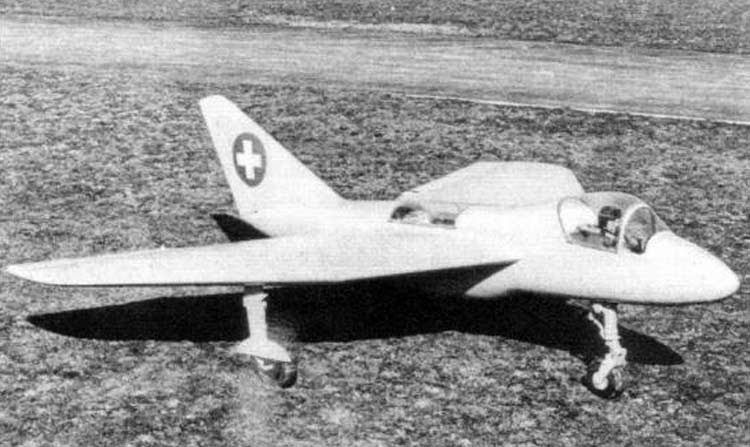In May 1948 the Swiss government issued a contract with the Federal Aircraft Factory in Emmen for a single-seat, multirole jet fighter called the N-20 Aiguillon ("Stinger") which was a moderately swept delta flying wing powered by four jet engines. The FAF staff had been working on a jet fighter design since the end of the Second World War and it was this work that spurred on the Swiss government to give the go-ahead for a production design based on the FAF's work. The original N-20 design called for indigenous Sulzer D45 engines of 1,600 lbs thrust buried in the wings, two on each side with its own intake on the wing leading edge. The engine air flow and wing design was unique in that bypass air could be ducted direct to the afterburner or deflected through large slots in the upper and lower wings to act as ailerons to enhance the aircraft's maneuverability or even be used as thrust reversers to operated off short runways in the mountainous valleys of Switzerland. The use of bypass air in this manner was novel for the time and was called "durchströmte flügel" which literally means "flowing through wing". Two of the engines could be shut down to increase range and weapons were to be carried in an underfuselage pack that could be swapped out depending upon the mission.
 |
| The N-20-1 glider |
Given the complexity of the design and that nothing of this scope had ever been tackled in Switzerland, it was decided to approach the project in stages with two research aircraft. The first aircraft was a 3/5 scale glider to study the aerodynamics which was designated N-20-1. The glider was made out of wood with fabric covered control surfaces and had a retractable undercarriage using the nose gear from a De Havilland Vampire and the main gears from a Messerschmitt Bf 109. It had provision for a JATO rocket to boost it for takeoff, though in practice the N-20-1 was usually towed to altitude for its flight test program. On 17 April 1948, the N-20-1 made its first flight at Emmen with the chief test pilot of the Swiss Military Technical Branch at the controls. Sixty-nine flights were made to validate the N-20 aerodynamics before the glider was heavily damaged in a landing accident on 1 July 1949.
 |
| The N-20-2 Arbalète in front of the N-20 Aiguillon |
The N-20-1 was then replaced by a similarly-sized test aircraft called the N-20-2 Arbalète ("Crossbow"). The Arbalète had its own jet power, though, in the form of four French Turbomeca Piméné turbojets, each pair mounted above each other at the trailing edge of the wing. The upper engine's intake was above the wing and the lower engine of the pair had its intake below the wing. The Piméné engine was a very small powerplant, developing only 220 lbs of thrust with a fan diameter of only about 15 inches. The Arbalète made its first flight on 16 November 1951 in a 16-minute test hop, become the first jet aircraft to be designed, built, and flown in Switzerland. Despite the low power of the engines, the N-20-2 reached a top speed in level flight of 345 mph at 13,000 feet and in a dive, reached a maximum speed of 447 mph. The generous lift from the broad wing of the Arbalète gave it a stalling speed of only 87 mph, remarkably low for jet aircraft of the day. With a fuel capacity of 52.8 gallons, the aircraft had a range of 155 miles or endurance of 40 minutes.
 |
| The sole N-20 Aiguillon prototype on musuem display |
Parallel to the flight test programs of the N-20-1 and N-20-2 Arbalète, work on the definitive N-20 Aiguillon fighter progressed. The Swiss firm Sulzer which was developing the D45 engines for the Aiguillon had numerous technical obstacles with only two prototype engines for bench testing having been built by 1948. Since the design needed slim jet engines to fit in the wings, a change was made to using a modified Armstrong Siddeley Mamba turboprop. Two Mamba engines coupled together to make the Double Mamba powered the Fairey Gannet ASW/AEW aircraft for the Royal Navy. The Swiss Federal Aircraft Factory modified the Mamba engine by replacing the propeller gearbox with a new low pressure fan to become the SM-1 engine (for Swiss Mamba) with 1,400 lbs of thrust. With its low pressure fan, the SM-1 was first flight tested on a De Havilland Mosquito in 1948, becoming one of the earliest turbofan designs to fly. The N-20 Aiguillon prototype began taxi trials on 8 April 1952 and it was soon realized the SM-1 engines didn't provide enough thrust despite being able to make a few short hops just shy of an official first flight. The SM-1 engines would need rework to a two shaft design designated SM-5 which would have generated 3,300 lbs of thrust, but the funding for the engine upgrade wasn't forthcoming from the Swiss government. The FAF tried to salvage the N-20 program with a redesign to what was called the N-20.20 Harpon which used a much more powerful Rolls Royce Avon turbojet in each wing root and dispensed with the novel air ducting in the wings. Wind tunnel models were tested before the Swiss government canceled the N-20 program, the Aiguillon prototype never having taken to the air.
Despite the cancellation of the Aiguillon fighter, the N-20-2 Arbalète continued to make research flights until 1954, having completed a total of ninety-one flights. It was retired to join the Aiguillon prototype in the Swiss Transport Museum where they can be seen today along with both the Sulzer D45 jet engines and the Swiss Mamba powerplants.
Source: X-Planes of Europe: Secret Research Aircraft from the Golden Age 1946-1974 by Tony Buttler and Jean-Louis Delezenne. Hikoki Publications, 2012, pp 92-97. Photos: Wikipedia


No comments:
Post a Comment